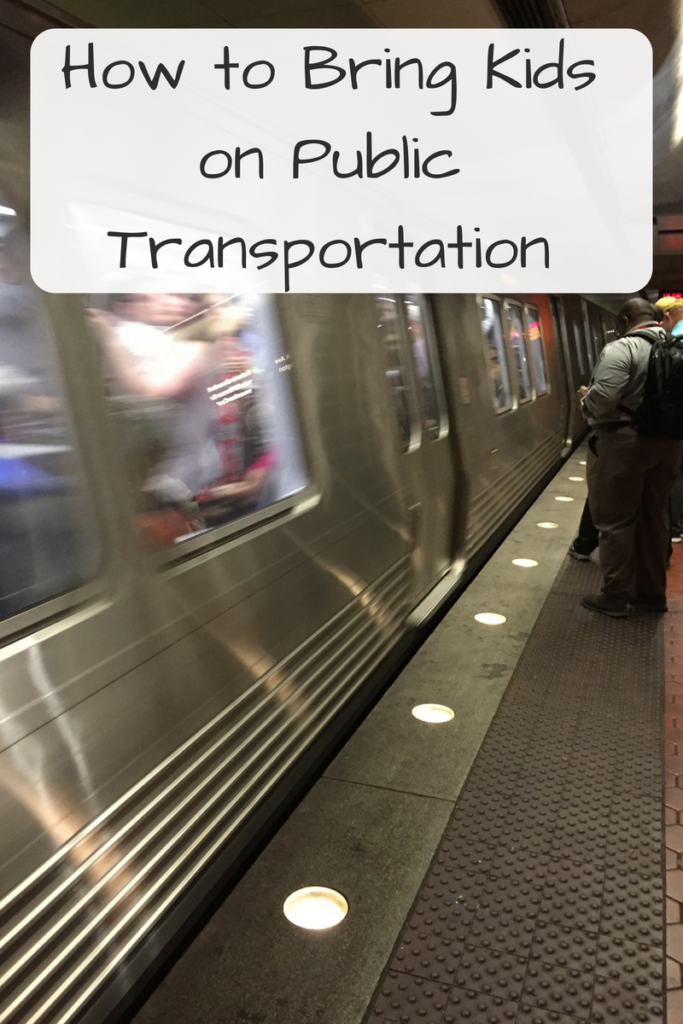Want to reduce your car use or get around a big city with your family? Be sure to learn what you need to know to bring kids on public transportation.

The train doors closed right in my five-year-old son’s face. He was on one side; his grandparents were on the other. They were not reopening.
Thankfully, my husband was next to my son on the other side of the doors. They got on the next train and all was well.
While this incident was frustrating, it’s definitely not stopped us from riding transit. We’re a one-car family and driving in the Washington D.C. area is dreadful. Riding the train and bus are second nature to my kids.
In fact, riding transit can be great for families. It’s a good option if you want to cut back on driving in your own area or just try something different. If you’re traveling, it’s the only good option in many cities with heavy traffic like New York City and D.C. Riding public transit can also be an adventure!
To avoid the problems we faced, it’s keep a few things in mind:
Stay together
This seems obvious, but requires you to really pay attention. Train platforms can be crowded. Buses require passengers to get on and off quickly. We got separated because my in-laws ran for the train and my son couldn’t keep up. Thankfully, my husband made sure to stay by his side.
Make a plan about what to do if you get separated
Hopefully, this will never happen. Nonetheless, we’ve drilled on our son what to do just in case. Because the manager’s booths for the D.C. Metro are nowhere near the tracks, we don’t want him to try to find a responsible adult. It’s more likely he’ll just get lost. Instead, if he gets left behind, he should stay exactly where he is. If he gets on the train without us, he should get off at the next stop and then wait until we keep up. Your particular plan should depend on the details of your own train or bus system.
Plan out and know exactly where you are going ahead of time
One of my wildest travel stories involves missing a mini-bus in rural Ireland and having to hitchhike. Another time, my husband and I ended all the way across town because we didn’t get off the bus early enough. As a result, I know the value of knowing exactly where to get on and off the bus.
Knowing how long the trip will take is helpful too. Because buses stop often, these trips can take longer than you might expect. My mom and I took the local bus route to the County Fair once and the trip ended up being a good 45 minutes longer than we expected. If we had actually looked at the bus map, we would have found a different bus that took a half-hour less.
These days, most bus and train websites provide good, clear transit schedules. In addition, many of them have apps that allow you to track exactly where the bus is. With a bus stop right outside my house, this has been revolutionary for me on rainy days!
Have the right equipment
Huge strollers can be difficult to drag on and off buses or onto the train. They can also cause problems if you’re riding the train during rush hour. Strollers that fold up easily with one hand or baby carriers are much better options.
Set expectations with your kids ahead of time
Even though my kids are a three-ring circus at home, they’re pretty well-behaved on transit. Part of it is because we talk about our expectations ahead of time. Just like they have to be in car seats in the car, they have to sit in seats on the train or bus, as long as they’re available. If it’s too crowded, they have to hold onto a pole and a parent’s hand.
Bring appropriate entertainment
Transit is often more exciting to kids than the car, if only because you often get a better view out the window. But longer trips can get dull. We often bring small toys, like Matchbox cars, to keep them occupied. If kids are watching videos or playing games with noise, be sure they have headphones. No one else wants to listen to the ever-so-catchy songs of Daniel Tiger. As a lot of subways have very limited cell service, it’s best to stick with things that don’t need to access the Internet. My five-year-old and I like playing the pass and play version of the train-themed game Ticket to Ride.
Use it to build independence
Public transit can offer families opportunities to build responsibility in kids.
With younger kids, you can have them follow where the train or bus is on the map and keep track of where to get off. My five-year-old loves figuring out how many stops are left. In addition, getting his own Metro card was a rite of passage. Now he has to go through turnstiles by himself and hand off his card to my husband afterwards.
As kids get older, you can offer them the chance to explore without the danger of operating a car. I hope that my kids learn to ride the bus and train by themselves long before they can drive. Not only will it mean that I don’t have to drive them everywhere under the sun, it will also allow them to build navigation skills and take responsibility for getting places on time.
Riding public transit with your kids can be rewarding and fun. But it’s a heck of a lot better if you know what you’re doing!
For more like this, check out Five Reasons I Ride the Bus with My Kids. If you are looking to connect with fellow parents trying to live more environmentally sustainably, check out my Green and Sustainable Parenting group on Facebook!